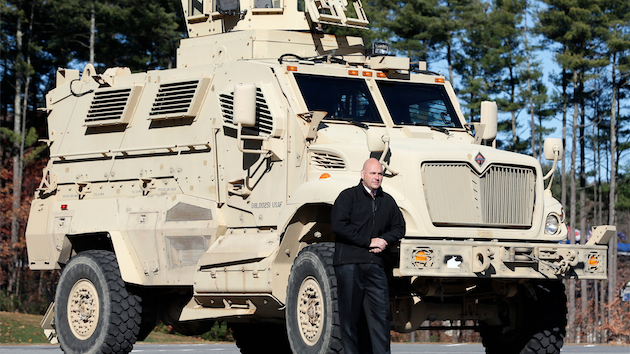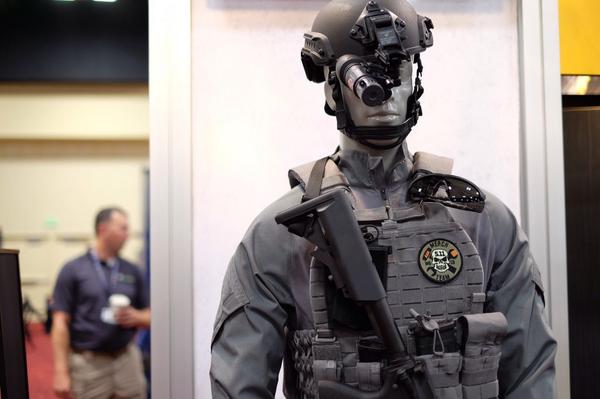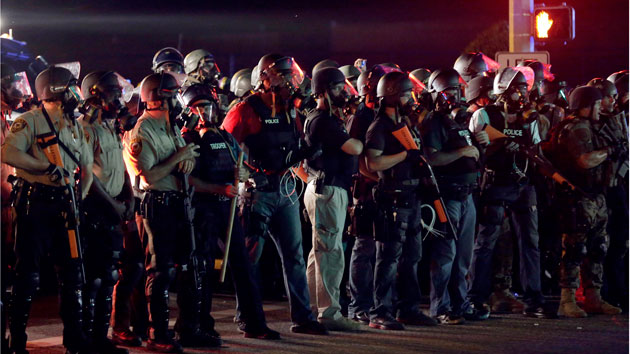By 7:30 on Thursday morning, the capacious ground-floor convention center of the Oakland Marriott was filled with SWAT teams. Mostly men, mostly white, dressed in camouflage or black fatigues, they stood in groups of eight or ten, some eating pastries, others sticking to coffee and a dip of tobacco. A few wandered the expo hall, stopping by booths to test the feel of armored vests, boot knives, and sniper rifles, grab swag like grenade-shaped stress balls, or drop tickets into a box for a raffle of iPhone covers and pistols.
“Want to see the new toy?” a vendor asked a police officer in camo. He handed him a pamphlet for his company, Shield Defense Systems. “This will blind anyone for 10 minutes. Imagine, walk into a bar fight, blind everyone, then figure out what’s going on. Some guys on drugs, you can put three slugs in their chest and it won’t stop them. But blind him, and I guarantee you he’ll calm down.” The device attached to a gun and sent out a frequency that the vendor said temporarily scrambled its target’s ocular fluid. The vendor turned to me—conspicuous for my lack of fatigues—and insisted the device caused no permanent damage (hence the name Z-Ro, as in “zero damage”), though he said it would probably make you nauseous. He expected it to be on the market this coming January.
The expo hall was just a warm-up to the main event: Starting at 5 a.m. on Saturday, 35 SWAT teams would compete in a two-day training exercise around the San Francisco Bay Area. The winning team would take home a trophy and the glory of having unseated the reigning SWAT champion—Berkeley, California.
Organizers of the conference, known as Urban Shield, said it was the largest first-responder training in the world; now in its eighth year, it has drawn teams from places as far-flung as Singapore, South Korea, Israel, and Bahrain. Each group would go through 35 tactical scenarios over 48 hours, with no breaks except the occasional catnap. An airplane was lined up for busting a gun smuggler, and a cargo ship would be seized by a terrorist after a make-believe earthquake. A “militant atheist extremist group” would take hostages at a church.
The event was paid for mostly by the Department of Homeland Security, but more than 100 corporations threw in money too, up to $25,000 each. In many of the scenarios, teams would try out the latest equipment on offer from Urban Shield’s corporate sponsors—Verizon, Motorola, SIG Sauer. Many were military supply companies—FirstSpear, for example, was founded by former soldiers to make body armor and bandoliers for “US and allied warfighters.” Here, they sold their stuff to cops. Then there were “platinum sponsors” like Uber, which gave police discount black-car rides for the weekend.
Urban Shield was started in 2007 by an Alameda County assistant sheriff named James Baker. In 2011, he told me, Homeland Security asked him to bring the event to other parts of the country, so he started a company, the Cytel Group, that would put on Urban Shield in Boston, Austin, and Dallas. “Urban Shield is a program that gets everybody working together” to respond to crises, he said. Baker’s firm has also received $500,000 in state funds to write guidelines for SWAT teams, on things like how much gear each team is required to have. When I spoke to him, he was in Kenya, where he had been contracted by the State Department to organize an Urban Shield-like training.

This summer, images of armored vehicles and police pointing semi-automatic rifles at demonstrators in Ferguson, Missouri, set off a debate over what journalist Radley Balko has termed the “rise of the warrior cop.” A National Public Radio analysis found that since 2006, the Pentagon has given local cops some $1.9 billion worth of equipment—including 600 mine-resistant, ambush-protected vehicles (MRAPs), 80,000 assault rifles, 200 grenade launchers, and 12,000 bayonets (yes, bayonets). But those totals pale in comparison to the amount of gear purchased from private companies. The Ferguson Police Department, for example, received some computers, utility trucks, and blankets from the military—but all that battle gear you saw on TV was bought from corporations like the ones pitching their wares at Urban Shield. Outfitting America’s warrior cops, it turns out, is a major business, and one fueled in large part by the federal Department of Homeland Security. The Department of Defense has given $5.1 billion worth of equipment to state and local police departments since 1997, with even rural counties acquiring things like grenade launchers and armored personnel carriers. But Homeland Security has handed out grants worth eight times as much—$41 billion since 2002. The money is earmarked for counterterrorism, but DHS specifies that once acquired, the equipment can be used for any other law-enforcement purpose, from shutting down protests to serving warrants and executing home searches.
For the vendors at Urban Shield, the task at hand was showing that these arsenals needed further beefing up. Semi-automatic rifles, for example, were once reserved mostly for SWAT teams and the military. Now they are standard squad car guns. At the Patriot Ordnance Factory booth, a vendor showed off the POF 308, a 14.5-inch military-style semi-automatic rifle that, he emphasized, fish and game officers used to shoot bears. An article in a gun magazine by a fish and game warden boasts that it’s also handy for raiding pot farms and fighting “narcoterrorists.” The vendor showed me the slightly smaller .223-caliber semi-automatics they’d started selling to the California Highway Patrol a year ago, for use in vehicle takedowns on the freeway. “The United States will forever be a nation of ready militia,” the company’s website said. For $5,100, it sold limited-edition, rotating bronze sculptures of a man in a tricorn hat, posed as though in battle, a sword on his belt, a tattered Colonial flag waving behind him, a POF semi-automatic rifle in his hand.
Farther down the hall, Homeland Security’s Science and Technology Directorate was showcasing a drone. It not only captured video, but was designed to drop objects at specified GPS coordinates, “like Hunger Games, if you will,” a representative from Robotics Research, DHS’s contractor on the project, told me. Buzzing around her booth was a cylindrical, remote-controlled robot that sold for $1,100. If the robot was too big to fit into, say, a building’s ventilation system, the police could make a smaller body on-site using a 3-D printer, then transfer the electric wiring.

Robots were popular in the convention hall. QinetiQ’s 20-pound Dragon Runner looked a bit like WALL-E, with treads like a tank and an arm that could be maneuvered like a miniature crane. Its pamphlet said it was meant for “some of the most hazardous conditions and terrains found on earth, from desert and mountain combat situations in the Middle East and Central Asia, to the streets of Europe and the United States.”
One of the most popular booths belonged to Tactical Electronics. A man extended a pole 20 feet into the air to demonstrate a special camera used for peering into windows. They sold cameras that could be slipped under doors and others made for strapping onto a dog, relaying video to a screen on the user’s wrist. They also had a device for steering the animal with vibrations to which it was trained to respond.
The event felt surprisingly open at first—vendors talked to me freely and I could sit in on workshops—but by the second day, I started noticing cops whispering to each other while looking in my direction. Some came over to feel me out, asking what I thought of the term “militarization.” One of them worked for the Northern California Regional Intelligence Center, a Homeland Security project to coordinate intelligence from local cops and federal agencies like the FBI. As I flipped through the counterterrorism handbook at his booth, he snatched it away. “That’s for law enforcement only,” he said. He told me he knew who I was.
The mission of the center is to “detect, prevent, investigate and respond to criminal and terrorist activity.” When another reporter, Julia Carrie Wong, visited their office during the convention, she found them tracking tweets from the few hundred protesters gathered outside.
From inside the hall, cops watched warily as the demonstrators chanted slogans about Ferguson. “If I see someone with an upside-down flag, I’m going to punch him in the face,” one said to his team. Nearby, a vendor sold shirts with slogans of his own. One bore the image of a Spartan helmet and the phrase “Destruction cometh; and they shall seek peace, and there shall be none.” His most popular shirt read “This Is My Peace Sign”; it showed crosshairs centered on what I briefly took to be a person with his hands up, though it was actually an AR-15 sight.
He told me to make sure I remembered one thing: We are sheep and police are the sheepdogs. They protect us, and they kill the wolves. I pointed at the shirt and asked, “The person in the sight, is that the flock or the wolf?”
“If he’s in the crosshairs, it’s gonna be the wolf,” he said. “It’s gonna be the bad guy.”
Special Weapons and Tactics teams were created in the late 1960s for extreme scenarios like saving hostages and taking down active shooters. But police departments soon began deploying them in more mundane situations. In 1984, just 40 percent of SWAT teams were serving warrants. By 2012, the number was 79 percent. In all, the number of SWAT raids across the country has increased 20-fold since the 1980s, going from 3,000 per year to at least 60,000. And SWAT teams are no longer limited to large cities: In the mid-1980s, only 20 percent of towns with populations between 25,000 and 50,000 had such teams. By 2007, 80 percent did.
Much of the increase has been driven by the drug war, says David Klinger, a former Los Angeles cop and a professor of criminal justice at the University of Missouri-St. Louis. “If we didn’t think that drugs were the most evilest thing in the history of God’s green earth,” he says, “and weren’t running hither and yon trying to catch people with dope in their house, none of this would have happened.”
Today, 85 percent of SWAT operations are for “choice-driven raids on people’s private residences,” Peter Kraska, an Eastern Kentucky University researcher who studies tactical policing, said in a recent Senate hearing. According to a study released by the American Civil Liberties Union earlier this year, 62 percent of SWAT deployments were for drug raids. The study found that in these raids, drugs were found only half of the time. When weapons were “believed to be present,” they were not found in half of the cases for which the outcome was known.

The study also found that while white people were more likely to be involved in the types of scenarios SWAT teams were intended for—like hostage or active-shooter situations—71 percent of today’s SWAT raids (when race was known) target people of color. The racial disparity can be much higher in some places: In Burlington, North Carolina, the study notes, African Americans are 47 times more likely to be affected by SWAT raids than whites.
SWAT officers have even come to be used to conduct “saturation patrol,” where extra police are deployed in a specific neighborhood. One SWAT commander told Kraska, “The key to our success is that we’re an elite crime fighting team that’s not bogged down in the regular bureaucracy. We focus on quality of life issues like illegal parking, loud music, bums, troubles.”
Standing in the expo hall near a booth where a charity was selling raffle tickets for an AR-15, I spoke with Sergeant JD Nelson, the spokesman for both Urban Shield and the Alameda County Sheriff’s Office. He was chatty and amicable. I asked him what he thought when people said the United States was becoming a police state. “I think there is some validity to that,” he said, explaining that “there’s some violent people out there. You turn on the news any given night and something terrible has happened. If you got a guy that’s wanting to do some harm and you have a choice between riding in a Crown Victoria or that“—he pointed to a huge black truck that looked like an armored personnel carrier—”you’re going to choose that every time.”
Jeremy Johnson, the tactical vehicle specialist at the Armored Group, sounded a similar note when he showed me the company’s ballistic armored tactical transport vehicle, or BATT. With a blast-resistant floor and a Batman-style insignia on its grill, it was designed to stop .50-caliber rounds and had front-mounted battering rams for busting into buildings, a 360-degree rotating turret, and sniper rifle mounts on the doors. The Armored Group sells the vehicles worldwide from offices in countries like Libya, Nigeria, and the United Arab Emirates.
“Some of these trucks do look intimidating,” Johnson said. “They should. You don’t want to pull up a Chevy Chevette in front of the house and say, ‘Here, we’re gonna get you.’ You’re not gonna get the effect you want.”
This was a common theme: Since the bad guys are well armed, police need better defenses and an intimidating appearance. And it’s true that guns on the street have gotten bigger—but it’s also true that being a cop today is the safest it has been since 1964. The most dangerous year in recent decades was 1973, when there were 134 felony killings of police officers in the line of duty. By 2012, that number had dropped to 47. Some of that might be because police are better protected, but they are also not being attacked as often: Assaults on cops are down 45 percent since their peak in 1971. Indeed, violent crime overall is down in America—it has fallen by nearly half since 1991.
In the end, the driving factor behind the police arms race may be not so much greater risk, but greater spending. This year, Homeland Security will give out $1.6 billion to state agencies and local police departments for counterterrorism and disaster preparedness. The Armored Group, Johnson told me, has its own grant-writing specialist to help police departments get the funds for its $100,000 to $300,000 vehicles. Police departments, the company’s website points out, also have the option of using “funds from assets seized in criminal activities”—money, cars, and other property—so long as the vehicle will be used for “drug enforcement in some capacity.” Forfeiture funds are a huge pot of money: The Washington Post found that in 2012, $4.6 billion in cash and goods was seized by police, in many cases without any criminal charges. And unlike Homeland Security dollars, forfeiture funds can be used to buy firearms.
Johnson said his vehicles were appropriate to use whenever police faced a “threat of violence,” from an active-shooter situation to a street protest. A rogue group of demonstrators might be armed, he said. They may “look innocent, which is great,” but they might also shoot at police. “No one wants to think about it, but it happens. We’ve seen it.” He couldn’t name an example, but advised me to “go back to the news footage.”
Johnson didn’t think “militarization” was an accurate term for what was happening with police. “They’re not buying a lot of things that would be considered military, in my opinion. Do they wear fatigues? Some of them do. Why is that? Well, a lot of that stuff’s proven by the military that it works. [But] it’s totally different training, it’s totally different scenarios.”
Or not so different. A 2007 study found that 49 percent of police departments surveyed used active-duty military personnel, including special-forces troops, to train their SWAT teams. One of the teams competing in Urban Shield was from the US Marine Corps. When the training event kicked off Saturday morning, I sat in an Amtrak train in Oakland as they came through in combat gear shouting at the pretend civilians to “put your fucking hands up! Anyone who puts their hands down will get fucking shot! Don’t fucking move!” Even though they were just shooting little plastic bullets, my heart was pounding. Afterward, I asked a Marine why they trained in exercises designed for police. “To learn different tactics,” he said. “You have some of the best guys out there, and they give their input and we take that back with us and teach our Marines.”
So the most powerful military in the world is taking cues from cops? “It’s interesting that we’ve had a lot of conversations on the militarization of the police, but you could make the same argument for the police-ization of the military,” said Nelson, the Urban Shield spokesman. The modern military is in the business of occupation, he said, of getting governments up and running. When the military fights insurgents, it is “almost acting like a police force.”
The Marines weren’t the only nonpolice team competing for the trophy at Urban Shield. The California Department of Corrections had a SWAT team present—its leader, Lieutenant Adam Dennis, told me the corrections department is actually the largest SWAT agency in the state, with 495 officers across 19 locations. They work as prison guards by day and are trained to do hostage rescue. Much of their SWAT work, though, doesn’t happen inside prisons, but with local police in communities where the prisons are located, Dennis said. The team this year, from Susanville, California, worked with police in the town of fewer than 16,000 people to do “warrants, drug eradication, narcotic surveillance—stuff like that.” Their training at Urban Shield—where they did mock assaults on jetliners—was meant to inform their work back home. “The tactics you use to take anything down, whether it’s a building, a plane, a train, an automobile—the tactics don’t change,” Dennis said. “It’s all the same.”
Other agencies fielding SWAT teams include NASA, the National Park Service, and the University of California-Berkeley, whose team I watched in a training exercise in Foster City. The scenario was this: A Muslim man had been fired from his job. He’d come back to his workplace, the participants were told, “screaming that he wanted to hurt the Jews for what they have done to him and his people.” He had been known to “visit pro-jihadist websites and anti-Semitic websites and many websites that instructed on how to build different types of weapons of mass destruction.” Detectives had found literature at his home proposing jihad against Israel. Now he was inside a classroom, holding a Jewish ex-coworker hostage.
When the SWAT team busted into the classroom, the commander shouted, “Gentlemen, we have a chemical!” A five-gallon bucket sat next to the Muslim hostage taker, liquid bubbling over toward the feet of the captive. The hostage was a dummy (or “smarty,” as they preferred to call it) with a sign taped to him that read “Alive but bleeding!!!!!” The team of eight burst in and trained their guns on the assailant, getting him to put his hands up as they dragged the hostage out. Then they pulled the terrorist out too, leaving the chemical to ooze onto the floor. That, they explained later, was for hazmat to deal with.
The UC-Berkeley team formed in 1992, their commander, Lieutenant Eric Tejada, told me, after a mentally disturbed, machete-wielding woman busted into the chancellor’s house on campus at 6 a.m. Today, he said, “most of what we do is high-risk warrants,” mostly going off campus to find suspects in muggings of students.
I left the training site feeling unsettled. If you were the hostage in a real-life version of one of these scenarios, would you want someone to come and save you? Of course you would. If you were a cop, would you want to be protected against anything that might come your way? Of course. And yet, nearly every SWAT cop I talked to at Urban Shield was spending most of his time doing drug busts, searching houses, and serving warrants.
“When equipment is requested for SWAT teams, it’s common to talk about the threat of terrorism [and] other rare but highly dangerous situations like hostage taking, barricaded suspects, and riots,” David Alan Sklansky, a Stanford law professor who studies criminal law and policing, told me. “But the majority of times that SWAT teams have been deployed, it’s been for more conventional kinds of operations.”

“SWAT teams definitely have legitimate uses,” he added. “But like lots of other things, when they are sitting around they can wind up getting used when they are not required and may do more harm than good.”
The next morning, my colleague Prashanth Kamalakanthan and I showed up at the Port of Oakland for a Bay Bridge training exercise. Each team in the competition had been on the move for more than 24 hours. Teams had been taking a boat out into the bay and climbing up into the underbelly of the bridge to disrupt a fake IED. We were planning to film the exercise, but when we arrived, the site manager told us that wouldn’t be possible. We could tag along, but no video.
I sighed, frustrated. When we’d applied for press passes, the sheriff’s department had welcomed our presence. They even encouraged us to film, noting that video did a better job than photos to “depict the hard work and dedication displayed.” But the day before we’d driven two hours to observe a raid on a pretend bomb factory only to be turned away, and now this. As we got ready to leave, we stopped by the trailer of HaloDrop, a robotics company that was displaying video screens, drones, and 3-D printers inside. They had intended to use their drones for recon on the bridge, but the sheriff’s office was still waiting for FAA approval to fly drones in the county.
After filming an interview with the HaloDrop representative, we discussed our plans for the rest of the day. Should we watch South Korea do an assault on an armored truck, then head over to see the prison guards evict a right-wing sovereign citizens group? As we talked, the HaloDrop vendor approached. “I’m not getting a good feeling from you guys,” he said. He warned us not to use the interview we’d just conducted. He had experience with the courts, he said. “I’ll just leave it at that.”
A few minutes later, a police officer came up to us in the parking lot and asked us to hand over our media badges. His captain had called, he said, and told him we had been filming at an unauthorized location. Where was that? I asked. “I don’t know. I assume it’s this site.”
Hours later, I got ahold of Sergeant Nelson, the Urban Shield spokesman. He said we’d been kicked out for “taking photos of an unauthorized area.”
“What area?” I asked.
“I don’t know. I assume it was the Bay Bridge.”
“We were not even near the Bay Bridge.”
“I don’t know what to tell you,” he said.
It seemed pointless to argue that, in the United States, photographing a bridge does not require police authorization.















